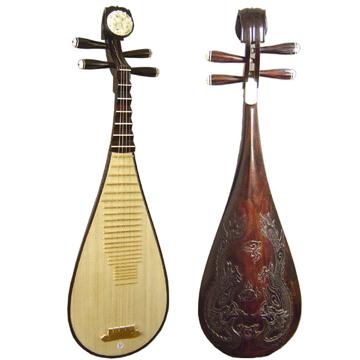MUSICAL CULTURE OF CHINA AND TAIWAN
A wise ancient Chinese philosopher named Confucius said that music has the power to make people behave well or not so well. The people of China have always believed that music could help make daily life better. So music is an important part of school and public life in Chinese culture.

China is a very large country in the far eastern part of Asia. Taiwan is an island off the southeastern coast of China. Chinese people and their culture have been in Taiwan for several centuries. Taiwan has sometimes been considered a part of China, and at other times has been independent of China. The musical traditions of China and Taiwan are entwined, and are among the world’s oldest.
Along with Chinese music and culture, the original folk traditions and music of Taiwan are still thriving there, especially in the mountain regions. Vocal music is very important to the mountain people of Taiwan, since it is one way that they preserve their history and traditions. They sing their history to younger generations, since they have not had a written language. The original people of the plains regions of Taiwan have mixed their musical traditions more with the music of China, so we know less about what their music was like before Chinese people came to Taiwan.
Chinese traditional music is based on the pentatonic scale. The meter is usually duple, and the rhythm is not very complex. As is true in many large countries, the music of China varies from region to region. The differences between vocal styles are related to the differences in language. Mandarin is the language spoken by most of the people in China. Each person in the rest of the population speaks one of over 60 different languages! Each language group has its own style of song and musical theater.Traditional Chinese instrumental pieces are mostly short and are based on stories and legends, nature, or true events. There are pieces for solo players and pieces for groups of three to twelve players. The player of each instrument ornaments a basic melody. There is a strong timbre contrast between instruments.
Traditional Chinese instruments include:
- Strings: lute, two-string fiddle, hammered dulcimer, and board zithers in different sizes
- Woodwinds: bamboo flute, recorder-like bamboo flute, and bamboo panpipes
- Percussion: a variety of large and small drums, normally played with beaters, and a variety of gongs, cymbals, and clappers
Peking Opera is a type of Chinese musical theater. The plots for these operas are based on popular legends, historical events, and literature. In this kind of opera the costumes and makeup are fancy, the set design is simple but colorful, and the actors use symbolic gestures and movements and sing in a high range with an intense quality. A band that is made up of traditional Chinese instruments, including pitched gongs, accompanies this singing.
Traditional music is still performed and listened to, though it is usually somewhat modernized. The traditional Chinese instrumental group has grown into an orchestra. With harmony now a regular part of the music, instruments of lower pitch have been developed to carry the bass line. The Western cello and bass are also used. Older music is arranged for these new instrument groupings, and newly-composed pieces are included, as well.

In Taiwan modern styles of pop and art music have developed more quickly since the tough laws and limits of the People’s Republic have not been in such force. Hong Kong’s pop music is also an important part of the music scene in China today are seemingly endless

